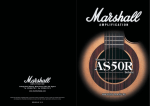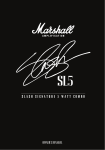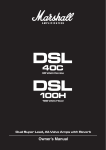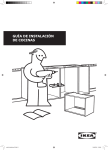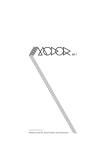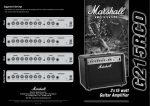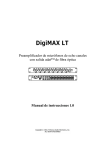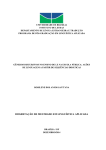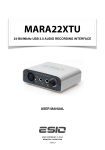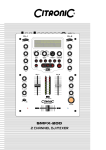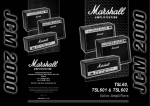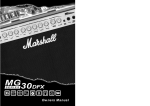Download AS50D Handbook - Marshall Amplification
Transcript
Introduction The AS50D is a compact and portable 50 Watt combo amplifier specially designed for use with acoustic instruments. Between its two channels, this combo has the flexibility to handle instruments with transducers, such as piezo or magnetic pick-ups (channel 1), or microphone for either vocal or instrument reproduction (channel 2). The built-in Chorus effect is assignable to either or both channels and the Reverb can be controlled and balanced between the channels to create just the right ambience. If you want to add further effects, then there is an on-board parallel effects loop which can be balanced between the channels in the same way as the Reverb. English For clear and detailed performance, the AS50D is loaded with two 8" speakers and a high fidelity polymer dome tweeter. There is also an internal limiter which allows you to push the maximum level from the 50 Watt output, whilst remaining distortion free. Neat and compact, flexible and portable, the AS50D is the ideal amplifier for the acoustic player who wants a system as suitable for small gigs as it is at home. Front Panel Features Channel 1 - Acoustic Instrument Channel 7. Jack Input Input to take any source, such as a drum machine, keyboard, etc. 1. Input Jack From the Chairman I would like to thank you personally for selecting the AS50D, Acoustic Soloist combo. The Marshall name has been associated with many fine products over the years and our commitment to quality remains as constant today as it did right back at the birth of Marshall Amplification back in 1962. In the case of the Acoustic Soloist, much time and research has gone into making the sound as natural as possible. As all of my designers are also guitarists, they fully understand the needs of the player and bring their expertise to bear on all our products. You can also rest assured that every Marshall amplifier has been designed and engineered to the highest possible standards, so as a result will stand the test of time and constant use. I strongly suggest that you read this handbook carefully before using your AS50D and then keep it on hand for future reference. I am certain that you will get great enjoyment from your Marshall Acoustic Soloist combo and wish you every success with it. Yours Sincerely, Plug the lead from your guitar in here. The high impedance of this input will help you to get the best from the passive or active piezo or magnetic pick-ups. 8. Volume Control Controls the volume level of the Microphone / Aux Channel 2. A good place to start with this control is the half way, or 12 o’clock position, then adjust according to the sensitivity of your pick-up 2. Volume Control Controls the volume level of the Acoustic Channel 1. A good place to start with this control is the half way, or 12 o’clock position, then adjust according to the sensitivity of your pick-up. 9. Bass Control Adjusts the amount of bass, or bottom end of your sound. Care should be taken when setting this control as adding excessive bass can cause unnatural howling. Again, the half way position is probably the best place to start. 3. Bass Control Adjusts the amount of bass, or bottom end of the instrument’s tone. Care should be taken when setting this control as adding excessive bass can cause unnatural howling. Again, the half way position is the best place to start. 10. Treble Control Adjusts the treble, or top end of your sound. Careful adjustment will make your high notes lively but not too harsh. It is worth noting that set in higher positions, this control will induce a certain amount of noise. 4. Treble Control Adjusts the treble, or top end of your sound. Careful adjustment will make your high notes lively but not too harsh. It is worth noting that set in higher positions, this control will induce a certain amount of noise. Master Section 11. Chorus Assign Switches Allows the built in Chorus effect to be selected on either channel individually, or both channels together. Channel 2 - Microphone / Aux Channel 5. Phono Inputs 12. Chorus Speed Control Inputs to take connection from a tape or CD player. Controls the speed of change of frequency for the built-in Chorus effect. 6. Microphone Input Balanced XLR type input for connection of a microphone and suitable for vocal or instrument applications. This input supplies phantom power. 13. Chorus Depth Control Controls the amount of change of the frequency shift for the built-in Chorus effect. Dr Jim Marshall OBE and daughter Victoria (Managing Director) 1 English One of the most difficult aspects of amplifying some acoustic instruments is feedback. To help you eliminate this, the AS50D features several ‘anti-feedback’ controls, including a Phase switch and a frequency controllable Notch Filter. The combination of these two elements will give you precise control of the frequencies where feedback is likely to occur and help you to eliminate them. Note: When using the Chorus, higher speed settings usually sound better with lower depth settings and vice versa. Experiment to find which selection suits you best. 18. Frequency Control If feedback occurs when the Master Volume is set to the desired performance level, select the switch (item 17) and rotate this control until the offending frequency is eliminated. 14. Reverb Balance Control 19. Master Volume English Controls the balance of the Reverb effect and the parallel effects loop between Channel 1 and Channel 2. Controls the overall volume output from the amplifier. 15. Reverb Level Control 20. Power Switch Controls the overall level of the Reverb effect. This is the On/Off switch for the mains power to the amplifier. When it is switched ‘On’, the switch will light. Please ensure the amplifier is switched off and unplugged from the mains electricity supply before being moved. 16. Phase Switch Switching the phase can considerably reduce the amount of low frequency acoustic feedback. 17. Notch Filter Switch Español Further feedback reduction can be achieved using the selectable frequency notch filter. When activated, the filter cuts by 10dB the frequency selected using the rotary control (item 18). Rear Panel Features 1. Mains Input 4. DI Out Your amp is provided with a detachable mains (power) lead that is connected here. The specific mains input voltage rating that your amplifier has been built for is clearly marked on the back panel. Before connecting for the first time, please ensure that your amplifier is compatible with your electricity supply. If you have any doubts, please get advice from a qualified person. Your Marshall dealer can help you in this respect. XLR type output for connection to PA or similar external equipment. Note: Both the Line Out and DI out carry exactly the same signal at different levels and both are placed before the Master Volume so changing the overall level of the amplifier will not affect the signal from the DI or Line Output. 5. Effects Send Jack Jack socket to connect to the input of an external effects processor. 2. Footswitch Jack Jack socket for connection of the optional footswitch (model PEDL-10029) for switching the Reverb and Chorus functions on and off. 6. Effects Return Jack Jack socket to connect to the output of an external effects processor. 3. Line Out Jack Jack socket for connection to home recording or other external equipment with jack inputs. Technical Specification 50W RMS into 4 Ω 1M Ω -10dBV +4dBV 1k Ω 16kg 542 x 416 x 261 Power Output Main Guitar - Input Impedance Line Output - Level FX Send Microphone - Input Impedance Weight Size (mm) 2 De Jim Marshall Me gustaría agradecerte personalmente el haber elegido el combo de guitarra acústica AS50D. El nombre Marshall ha estado asociado a equipos de amplificación de primera línea durante estas últimas décadas, y hemos mantenido celosamente nuestro compromiso con la calidad desde el nacimiento de Marshall Amplification en 1962. En el caso de nuestros amplificadores de acústica no hemos escatimado tiempo ni esfuerzos hasta lograr un sonido lo más natural posible. Puesto que todos mis diseñadores son guitarristas, tenemos un profundo conocimiento de las necesidades de los músicos y esto queda patente en todos nuestros productos. Además puedes tener la seguridad de que todos y cada uno de los amplificadores Marshall son diseñados y construidos bajo los más estrictos estándares de calidad y de que están preparados para el examen del uso continuado durante años. Te sugiero que leas este manual antes de usar el AS50D y que lo conserves como referencia en el futuro para poder obtener el máximo rendimiento. Quiero desearte éxito en todos tus proyectos musicales y felicitarte por tu nuevo Marshall AS50D, que estoy seguro que te acompañará muchos años. Un cordial saludo, Fotografía: Dr. Jim Marshall OBE y su hija Victoria (Directora General) 3 AS50D Front Panel 16 Acoustic Channel 1 Microphone / Aux Channel 2 Chorus Reverb / Loop Reverb Anti-Feedback Master L Ch1 Phase R Ch2 0 10 - + - + 0 10 - + - + Input Volume Bass Treble Aux Microphone Input Volume Bass Treble 1 2 3 4 5 6 7 8 9 10 AS50D Rear Panel 1 2 3 4 5 Notch 0 11 10 0 10 Ch1 Ch2 0 10 Speed Depth Balance Level 12 13 14 15 80Hz 17 1kHz 0 10 Frequency Volume Power 18 19 20 6 AS50D Block Diagram VOL BASS TREBLE INSTRUMENT TWEETER SEND VOL BASS MASTER PHASE NOTCH BALANCE TAPE IN RETURN LEVEL FREQUENCY -1 REVERB TREBLE CROSSOVER PA LIMITER FOOTSWITCH LINE OUT MIC CH 2 SPEED DEPTH AUX D.I. CH 1 16 CHORUS FOOTSWITCH 17 DRIVER




